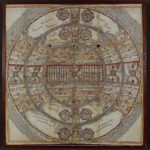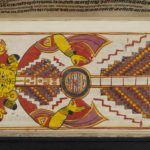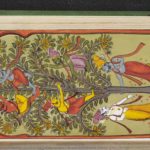Article: Jain universe
The universe for Jains is an elaborate system that shares features with other Indian traditions. For instance, the repetition of identical structures is also a characteristic of Buddhist cosmology.
But, on the whole, Jain cosmology is very distinctive. Its chief distinguishing principles are:
- the absence of a creator god
- the everlasting and non-originating nature of the universe
- two types of space – ‘world space’ and ‘non-world space’
- a perfect, orderly structure characterised by symmetry and repetition
- underlying mathematical concepts
- the notion of cycles of time.
The Jain conception of the universe has been handed down over the centuries and is a good example of a scholarly teaching that is widespread among lay believers. Grasping Jain cosmology is vital to understanding the Jain religion because it shows several key concepts working together, including the:
- notion of a physical soul moving through the cycle of rebirth to eventual omniscience
- cyclical nature of time
- interconnectedness of the universe
- importance of symmetry, repetition and balance.
Progressing spiritually requires understanding and meditating upon these cosmological theories.
World space – loka-ākāśa – has three worlds, through which souls move on their spiritual journey. The lower world, the middle world and the upper world are crowned by a realm where the liberated souls are together in everlasting bliss. Souls move through the worlds according to their karma, which derives from behaviour. Jains hope to develop spiritually to finally reach omniscience, then attain liberation and live in the siddha-śilā.
Passing on accurate understanding of the complexities of traditional cosmology is therefore very important to Jains. The main way of communicating these has been through various kinds of writings on the universe, including scriptures, cosmological treatises and popular tales. However, a solid tradition of visual art developed from the earliest times and images of the universe still form a significant part of Jains’ artistic heritage and religious understanding today. A common cosmological theme in art is the three worlds and the siddha-śilā of liberated souls, which are frequently pictured as parts of the figure of a human being, known as the ‘cosmic man‘.
The two main sects of Jain belief, the Śvetāmbara and Digambara, agree on the structure of the universe and its elements but differ on many names and numbers. Perhaps a bigger potential area of difficulty is reconciling traditional theories with modern science. It is likely that the majority of contemporary Jains takes a practical approach and accepts scientific developments while continuing to study traditional cosmological theories for religious reasons.
General principles
Jain cosmology has several distinguishing features that mark it out from other Indian notions of the universe, time and the human place within it. The first is the timeless nature of the universe. Second, there are two kinds of space within the Jain universe – world space and non-world space. Next, repetition and symmetry are crucial elements to the patterns of the universe. Perhaps underlining this factor, mathematics offers an important method of understanding and categorising the complexities of the universe and time.
No beginning and no end
The universe is without beginning and without end, it is without the characteristics of permanence, origination, and perishing. It was made by no one and is supported by no one. It is self-produced and, moreover, remains in space without support
Tri-ṣaṣṭi-śalākā-puruṣa-caritra
Translation by Helen M. Johnson, 1937, pages 104 to 127
Thus the scholar-monk Hemacandra describes the universe in the 12th century. One of the most important points is that there is no creator who is involved at any stage in producing or running the world. This is a significant difference from Hindu belief, in which Brahmā, Viṣṇu and Śiva have roles in creation, protection and destruction respectively.
World space and non-world space
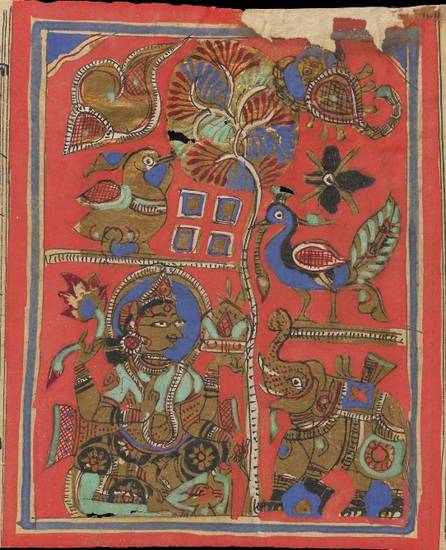
Examples of types of living beings
Image by British Library © CC0 1.0 (Creative Commons Public Domain)
To Jains the universe is composed of two types of space. World space – loka-ākāśa – is a vast but limited area, which is the focus of cosmology as covered in this article. Here all the souls live in the different body-forms they take according to their rebirths in the various worlds. Outside world space is the non‑world space – aloka-ākāśa – which is endless.
World space contains only insentient and sentient substances. There are three types of substances – dravyas – in world space.
The first type is the sentient substance – soul or jīva – while the second is an insentient substance, known as matter or pudgala.
The third group is composed of the insentient, non-material substances of:
Some authorities include the substance of time – kāla.
Beings with one sense – ekendriya – can live anywhere in world space and are mobile but beings with more than one sense must live only in the three worlds of the trasa-nāḍī. Beings with more than one sense include humans, animals, hellish beings and heavenly beings.
Symmetrical, repetitive structure

Temples and trees on Mount Meru
Image by British Library © CC0 1.0 (Creative Commons Public Domain)
The Jain universe is perfectly structured and ordered. One of its governing principles is symmetry and repetition, so that “To know one part is to know the whole” (Granoff 2009: 55). This universe is “a self-replicating composite” (Granoff 2009: 56). Examples of this recurring, symmetrical structure include:
- how the various categories of deities are organised socially along the same principles as human societies, in which the ideal form of government is kingship, and so the gods and asuras are governed by kings – indras
- how each of the halves into which the continents of the middle world are divided is a replica of the Jambū-dvīpa
- how Airāvata, the northern region of the Jambū-dvīpa, is an exact replica of Bharata, the southern region
- the ever-repeating cycles of descending and ascending periods of time in some parts of the universe.
Mathematics and units of time and space

Distances separating the suns and moons
Image by British Library © CC0 1.0 (Creative Commons Public Domain)
Jain cosmology is based on mathematics, both calculations and geometry formulae. Mathematics is an area of knowledge where the Jain contribution has been very substantial.
The Jain universe is thought of in terms of dimensions and quantities of units. The mathematics of the universe are discussed at length in philosophical and sacred literature, starting with definitions of time and space units. Jain thinkers have produced a vast vocabulary to describe and understand units of time and space, going from the smallest to the largest, beyond what can be imagined.
Components of Jain cosmology are classified in one of the following ways:
- numerable – saṃkhyeya
- innumerable – asaṃkhyeya
- infinite – ananta.
The smallest unit of physical matter is the atom. Infinite combinations of atoms make up the smallest unit of measurement that can be counted. This is called the ‘extremely fine’.
Similarly, the Jains have gone into great detail in analysing the extremely large or highly numerous (Plofker in Granoff 2009: 65ff.).
Religious purpose
Teaching cosmology is a specialist task, which mendicants mostly carry out. But learning is meant for all. Meditating on the universe and understanding how it is built and works are crucial steps to progressing spiritually on the way to salvation.
Part of the doctrinal idea of meditation, contemplating the universe is one of the 12 topics for reflection – anuprekṣā. Jains meditate on the structure of the universe as much as on transmigration, the circulation of the soul through the universe.
Souls move among different parts of the world depending on how they act when they are in a body. Karma and cosmology are therefore closely connected in Jain belief. Human beings are lucky enough to be born in a part of the world where their spiritual development is in their own hands. Truly understanding what the material universe is and realising that it is something different from the soul or one’s spiritual essence is one of the main purposes of the study of cosmology.
The multitude of descriptions and classifications and the extremely large numbers found in Jain cosmology provoke a kind of dizziness. Their purpose is to underline the good fortune in being born a human being, a chance that should not be wasted. It is a rare opportunity because humans live in an extremely small fraction of the vast universe.
The three worlds

Cosmic man
Image by British Library © CC0 1.0 (Creative Commons Public Domain)
The world space where all the souls live is divided into three worlds, frequently represented as the cosmic man. Karma is closely connected with cosmology in the Jain tradition, so being familiar with the complex nature of the Jain universe is essential to fully understand Jain belief.
The souls move through the three worlds in a cycle of rebirth which only ends when a perfect spiritual state is reached. When a soul has progressed spiritually far enough to reach omniscience or perfect knowledge, it has no karma and can break free of the cycle of births, becoming a liberated soul or siddha. In the meantime, the cycle of birth takes place throughout the three worlds.
Within world space, the three worlds are:
- the lower world, labelled adho-loka – formed of seven hells
- the middle world, called madhya-loka – the only place where human beings live
- the upper world, known as ūrdhva-loka – comprising the heavens.
There is also an area at the top of the worlds where the liberated souls live in neverending bliss, called the siddha-śilā.
Cycle of rebirth, karma and four types of being
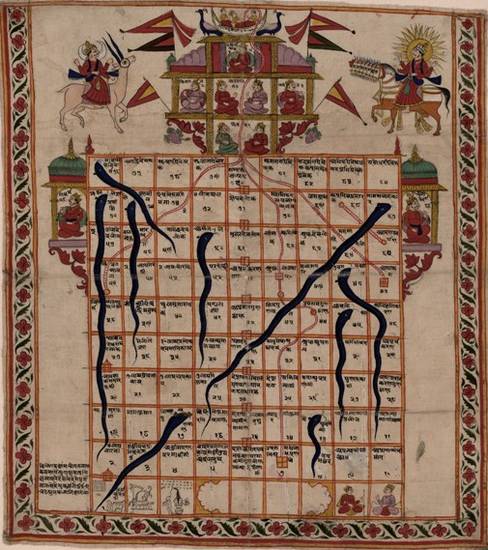
Snakes and ladders
Image by Victoria and Albert Museum © V&A Images/Victoria and Albert Museum, London
All souls move around the worlds through the cycle of birth, in which they are born in different states in the various areas of the three worlds. Souls are born into one of four states. Which state and which world depends on their spiritual condition.
The spiritual state of a soul stems from its karma, which derives from actions in its previous life and, to some degree, on karma from lives before that one. Therefore a soul may be born into very different conditions in successive lives. For example, a soul born in a heaven in one life may behave so badly that it gains huge amounts of very negative karma and is then reborn in a hell in its next life. There it will suffer great torments and find it extremely hard to get enough positive karma to rise to a higher body in a better world.
However, just as spiritual progress is not simple, so the soul’s movement around the different worlds is not straightforward. Spiritual improvement is a very gradual, difficult process and involves many births in many different areas of the worlds in a sequence that is neither all forward progress nor all downward spiral.
The soul is born in one of the following states – gati:
- a human being – manuṣya-gati
- a heavenly being, living in the heavens – deva-gati
- an infernal being, living in the hells – naraka-gati
- an animal or plant – tiryag-gati.
Souls that have a greater level of spiritual development are born into higher worlds. Even so, being born into a heaven is worse than being born into the middle world as a human being. Only souls born as humans can reach omniscience and thus liberation of the soul, and humans are born only in the middle world.
Although the beings in the upper world are heavenly beings or gods, not all gods and goddesses live in the upper world. Deities live in all of the worlds, and also in a space between the highest hell and the surface of the earth, just below the middle world of humans.
Cosmic Man
The three worlds are usually depicted in a diagram known as the Cosmic Man – loka-puruṣa. The stylised body of a human figure is divided into three parts, each standing for the one of the three worlds. His bottom half symbolises the lower world, his waist represents the middle world and his torso is equivalent to the upper world. The siddha-śilā is represented by a crescent moon on his forehead.
Lower world – the seven hells
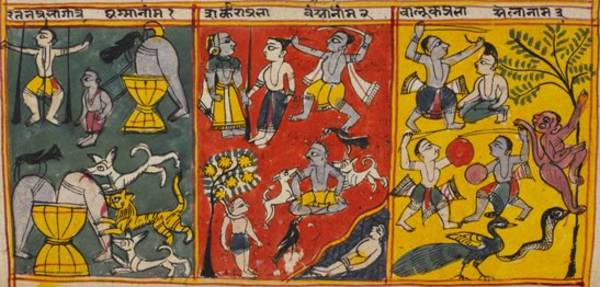
Infernal tortures
Image by British Library © CC0 1.0 (Creative Commons Public Domain)
The lower world is a place of agony. Residents of the hells suffer more the lower they live. Artists love to create vivid pictures of life there and the wide range of tortures hellish beings go through.
Souls are born in the hells because they have behaved violently and been extremely possessive. Such attitudes and actions break fundamental rules governing Jain life. If the hellish beings do not behave well enough to build up enough good karma to be reborn into a higher world, they are reborn next in a lower hell.
Middle world – the world of humans
The primary principle of repetition in the Jain conception of the universe is very clear in the middle world. It is circular and consists of continents alternating with oceans in concentric circles.
Although there are 90 continents and oceans in the middle world, many are nothing more than names, with little information in any source. The first continent, Jambū-dvīpa, is the most noteworthy and is the template on which all the other continents are modelled.
Jambū-dvīpa forms the heart of Aḍhāī-dvīpa, which means ‘Two and A Half Continents’.
The Two and A Half Continents comprises:
- Jambū-dvīpa
- the surrounding ocean of Lavaṇa-samudra
- the second continent, Dhātakīkhaṇḍa
- the encircling ocean, Kālodadhi
- one half of the Puṣkara continent.
The Two and A Half Continents is the only area in the three worlds where human beings can be born.
The Two and A Half Continents is frequently represented in picture form in detailed diagrams or maps that are also beautiful works of art.
Upper world – the heavens

Pairs of gods in their heavenly palaces
Image by British Library © CC0 1.0 (Creative Commons Public Domain)
The beings – deities – that live in the upper world never suffer. Instead they enjoy constant pleasure and happiness.
However, even though they are gods, they have not reached spiritual perfection. They are still souls trapped within the cycle of births. Since only human beings can progress spiritually to omniscience and then salvation, being born a heavenly being is still at least one birth away from liberation.
Reading
- Commentary on Tattvārtha Sūtra of Vācaka Umāsvāti
Pandit Sukhlalji - translated by K. K. Dixit
L. D. series; volume 44
L. D. Institute of Indology; Ahmedabad, Gujarat, India; 1974
- Steps to Liberation: 2500 Years of Jain Art and Religion
Jan van Alphen - Etnografisch Museum Antwerpen; Antwerp, Belgium; 2000
- ‘Une peinture cosmologique jaina déposée au Musée Guimet: texte et traduction’
Nalini Balbir - Bulletin d’Études Indiennes
volume 24–25
Association Française pour les Études Indiennes; Paris, France; 2006 to 2007
- ‘Le monde médian: une peinture cosmologique jaina sur tissu déposée au Musée Guimet’
Nalini Balbir - Arts Asiatiques
volume 64
École Française d’Extrême-Orient; Paris, France; 2009
- Elements of Jaina Geography: The Jambūdvīpasaṃgrahaṇī of Haribhadra Sūri
Haribhadra - translated and edited by Frank van den Bossche
Motilal Banarsidass; New Delhi, India; 2007
- Jain Cosmology
Colette Caillat and Ravi Kumar - translated by R. Norman
Bookwise (India) Pct. Ltd; New Delhi, India; 2004
- Essays on Jaina Art
Anand K. Coomaraswamy - edited by Richard J. Cohen
Indira Gandhi National Centre for the Arts and Manohar; New Delhi, India; 2003
- Victorious Ones: Jain Images of Perfection
Phyllis Granoff - Mapin Publishing Pvt. Ltd and Rubin Museum of Art, New York; Ahmedabad, Gujarat, India and New York, USA; 2009
- ‘Oceans, Islands and Sacred Mountains: Representations of Cosmic Geography in Jaina Art and Architecture’
Julia A. B. Hegewald - Cosmos: the Journal of the Traditional Cosmological Society
volume 16
Traditional Cosmological Society; 2000
- ‘Meru, Samavasaraṇa and Siṃhāsana: The Recurrence of Three-Tiered Structures in Jaina Cosmology, Mythology and Ritual’
Julia A. B. Hegewald - Kalhar (White Water-Lily): Studies in Art, Iconography and Archaeology of India and Bangladesh – Professor Enamul Haque Felicitation Volume
edited by Gerd R. Mevissen, Gourishwar Bhattacharya, Mallar Mitra and Sutapa Sinha
Kaveri Books; New Delhi, India; 2007
- Jaina Temple Architecture in India: The Development of a Distinct Language in Space and Ritual
Julia A. B. Hegewald - Monographien zur Indischen Archäologie, Kunst und Philologie series; volume 19
Stiftung Ernst Waldschmidt, G+H Verlag; Berlin, Germany; 2009
- Cosmology Old & New: Being a modern commentary on the fifth chapter of Tattvārthādhigama Sūtra
G. R. Jain - Jñānapīṭha Mūrtidevī granthamālā: English series; volume 5
Bhāratīya Jñānapīṭh Publication; New Delhi, India; 1991
- ‘Lokākāśa and Lokadhātu: A Comparison of Jain and Buddhist Cosmology’
Padmanabh S. Jaini - The Clever Adulteress and Other Stories: A Treasury of Jain Literature
edited by Phyllis Granoff
Mosaic Press; Oakville, Ontario, Canada; New York, USA; London, UK; 1990
- Die Kosmographie der Inder: nach den Quellen dargestellt
Willibald Kirfel - Georg Olms; Hildesheim, Lower Saxony, Germany; 1967
- The Scientific Foundations of Jainism
K. V. Mardia - edited by Dayanand Bhargava
Lala Sunder Lal Jain Research series; volume 5
Motilal Banarsidass; New Delhi, India; 1996
- Die Erlösungslehre der Jaina: Legenden, Parabeln, Erzählungen
- translated and edited by Adelheid Mette
Insel Verlag; Berlin, Germany; 2010
- The Doctrine of the Jainas: Described after the Old Sources
Walther Schubring - translated by Wolfgang Bühlen
edited by Satya Ranjan Banerjee
Lala Sunder Lal Jain Research series; volume 15
Motilal Banarsidass; New Delhi, India; 2000
- That Which Is: Tattvārtha Sūtra
Umāsvāti / Umāsvāmi - translated by Nathmal Tatia
Sacred Literature series
International Sacred Literature Trust in association with Harper Collins; London, UK; 1994
- Treasures of Jaina Bhandāras
Umakant Premanand Shah - L. D. series; volume 69
L. D. Institute of Indology; Ahmedabad, Gujarat, India; 1978
- Tiloyapannatti: Teaching on the Three Worlds
Yativṛṣabha - translated by Pandit Balchandra Shastri
edited by A. N. Upadhye and Hiralal Jain
Jaina Saṃskṛti Saṃrakshaka Sangha series
Jīvarāja Jaina Granthamālā; Solapur, Maharashtra, India; 2008
Links
- Jain universe
-
The Herenow4U website provides a detailed diagram of the Jain universe and a summary of traditional cosmology. It is a page from the 2008 edition of Introduction to Jainism by Rudi Jansma and Sneh Rani Jain.
- Three-dimensional model of Jambū-dvīpa
-
This slideshow from the Digambar Jain Trilok Shodh Sansthan – Digambar Jain Institute of Cosmographic Research – in Hastinapur, Uttar Pradesh, shows photos of its three-dimensional model of Jambudweep – Jambū-dvīpa in Sanskrit – and other pictures of the institute. Some 70 metres across, the model of the first continent houses a 30-metre-tall Mount Meru up which visitors can climb.
http://www.jambudweep.org/gallery/jambudweep-campus-photo-gallery
- Restoring a Jain paṭa
-
The National Museum of Scotland provides details of restoration carried out on a 19th-century wall-hanging – paṭa – of the Jain triple world. A slideshow of photographs of the conservation process and some of the results is also offered.
- Āryikā Jñānamati – Jain Triple World Research Institute
-
One of the most influential women in contemporary Jainism, Āryikā Jñānamati is a Digambara nun. Her achievements and character inspired the 1974 foundation of the Digambar Jain Trilok Shodh Sansthan – Jain Triple World Research Institute – in Hastinapur, Uttar Pradesh. Here described by her name in modern Hindi, Āryikā Jñānamati is profiled on the institute's website.
- Digambar Jain Trilok Shodh Sansthan
-
Opened in 1985, the Digambar Jain Trilok Shodh Sansthan – Digambar Jain Institute of Cosmographic Research – in Hastinapur, Uttar Pradesh, was founded by Āryikā Jñānamati. A centre of research into Jain cosmology, the institute publishes the Vira Jñānodaya Granthamālā series and the Samyagjñāna journal and also houses a boys' boarding school. Several temples attract pilgrims but the main draw is the large 3-D model of Jambūdvīpa, complete with a 30-metre-tall Mount Meru.
- +
- aAbhavya
- aAbhinandana
- aAbhiṣeka
- aĀcāra
- aĀcārāṅga-sūtra
- aĀcārya
- aAchalbhrata
- aAḍhāī-dvīpa
- aAdharma
- aAdho-loka
- aAdhyayana
- aAdvaita Vedānta
- aĀgama
- aAghātīya
- aAghātīya-karman
- aAgnibhuti
- aAgra
- aĀhāra
- aAhiṃsā
- aAhimsa Day
- aAjita
- aAjīva
- aAkampit
- aĀkāśa
- aAkbar the Great
- aAkṣaya-tṛtīyā
- aAlauddin Khalji
- aAlbert Einstein
- aAllah
- aAlms
- aĀlocanā
- aAloka-ākāśa
- aAmāri
- aAmbikā or Kūṣmāṇḍinī
- aAnagāra
- aAnanta
- aAnarthadaṇḍa
- aAnaśana
- aAnekānta-vāda
- aAṅga
- aAniconism
- aAnojjā
- aAntarāla
- aAntarāya-karma
- aAṇu
- aAṇu-vrata
- aAnukampā
- aAnuprekṣā
- aAnusvāra
- aApabhraṃśa
- aAparigraha
- aAra
- aĀrambha
- aĀrambhaja
- aĀratī
- aArdhamāgadhī Prākrit
- aArhaṃ
- aArhat
- aArśana-āvaraṇīya-karma
- aĀrta-dhyāna
- aĀryikā
- aĀryikā Jñānamati
- aĀśātanā
- aĀścarya
- aAscetic
- aAsceticism
- aAshram
- aAspiration
- aĀsrava
- aAṣṭa-maṅgala
- aAṣṭāpada
- aAstikāya
- aAstrolabe
- aAsura
- aAtheism
- aAticāra
- aAtiśayakṣetra
- aAtithisaṃvibhāgavrata
- aĀtma-vāda
- aĀtman
- aAuṃ
- aAurangzeb
- aAuspicious
- aAusterity
- aAvadhāna
- aAvadhi-jñāna
- aĀvaraṇī-yakarman
- aAvasarpiṇī
- aAvatāra
- aAvidyā
- aAxiom
- aĀyāga-paṭa
- aĀyambil
- aĀyu-karma
- aĀyurveda
- bBabur
- bBāhubali
- bBaladeva
- bBālāvabodha
- bBandha
- bBasadi
- bBazaar
- bBhadrankarvijay
- bBhagavant
- bBhaktāmara-stotra
- bBhakti
- bBhale
- bBharata
- bBhāṣā
- bBhāṣya
- bBhaṭṭāraka
- bBhāva
- bBhāva-pūjā
- bBhāvanā
- bBhavana-vāsin
- bBhavya
- bBhavyatva
- bBhaya
- bBhoga-bhūmi
- bBhogopabhoga
- bBodhi
- bBollywood
- bBrahmā
- bBrahma-deva
- bBrahmacārī
- bBrāhmaṇa
- bBraj Bhāṣā
- bBright fortnight
- bBritish Raj
- bBuddha
- bBuddhi-sagar
- bBuddhism
- bBuddhist
- cCaitya
- cCaityavāsin
- cCakravartin
- cCakreśvarī
- cCāmara
- cCandanā
- cCandragupta
- cCandraprabha
- cCanon
- cCāritra
- cCāritramohanīya-karman
- cCarũrī
- cCaste
- cCaturvidha-saṅgha
- cCaturviṃśati-stava
- cCāturyāma
- cCE
- cCelibacy
- cCha
- cChadmastha
- cChastity
- cCheda-sūtra
- cChristian
- cChristianity
- cClergy
- cCloning
- cColophon
- cCommentary
- cConch
- cConfession
- cCongregation
- cConsecration
- cCosmology
- cCremation
- cCrore
- cCult
- cCūrṇi
- dDādā-guru
- dDalit
- dDāna
- dDaṇḍa
- dDark fortnight
- dDarśana
- dDarśanamohanī-yakarman
- dDaśa-lakṣaṇa-parvan
- dDeity
- dDelhi Sultanate
- dDerāsar
- dDeśāvakāśika-vrata
- dDetachment
- dDevanāgarī
- dDevānandā
- dDevarddhi-gani
- dDevotee
- dDhamal
- dDhanuṣ
- dDhāra
- dDharma
- dDharma-dhyāna
- dDharma-sāgara
- dDharmastikaya
- dDhātakīkhaṇḍa
- dDholak
- dDhyāna
- dDiaspora
- dDig-vrata
- dDigambara
- dDīkṣā
- dDisciple
- dDīvālī
- dDivya-dhvani
- dDNA
- dDoctrine
- dDogma
- dDonor
- dDoṣa
- dDravya
- dDravya-pūjā
- dDrone
- dDuṣamā
- dDuṣamā-duṣamā
- dDuṣamā-suṣamā
- dDveṣa
- dDvīpa
- eEast India Company
- eEightfold Path
- eEkānta-vāda
- eEkendriya
- eElder
- eElders
- eEschatology
- eEtc up to
- fFarmān
- fFast
- fFatehpur Sikri
- fFestival
- fFestschrift
- fFiruz Shah
- fFly-Whisks
- fFolio
- fFour Noble Truths
- gGaccha
- gGaṇa
- gGaṇadhara
- gGanadharavada
- gGaṇeśa
- gGaṇin
- gGarba
- gGarbha
- gGarbha-gṛha
- gGaruḍa
- gGati
- gGene
- gGenomics
- gGhātī-yakarman
- gGhātīya
- gGhaznavid
- gGhiyasuddin Tughlaq
- gGhurid
- gGloss
- gGotra-karma
- gGujarāt
- gGujarati
- gGuṇa
- gGuṇa-sthāna
- gGuṇa-vrata
- gGupti
- gGuru
- gGuruṇī
- hHagiography
- hHajj
- hHaṃsa
- hHaribhadra
- hHariṇaigameṣin
- hHasta
- hHeresy
- hHiṃsā
- hHindi
- hHindu
- hHinduism
- hHīravijaya
- hHoroscope
- hHrīṃ
- hHumayun
- hHymn
- iIconoclasm
- iIconography
- iIdol
- iIndian Independence
- iIndology
- iIndra
- iIndrabhūti Gautama
- iIndriya
- iInitiation
- iIntercession
- iInvocation
- iIQ
- iIslam
- iIslamicate
- iIṣṭadevatā
- iĪśvara
- jJagat
- jJahangir
- jJain
- jJaina Devanāgarī
- jJaina Śaurasenī
- jJaina-dharma
- jJainaśāsana
- jJainness
- jJaisalmer
- jJamāli
- jJambū-dvīpa
- jJames Burgess
- jJanma
- jJanma-kalyāṇa
- jJarā
- jJāti
- jJina
- jJina-āgama
- jJina-bhavana
- jJina-bimba
- jJina-mātā
- jJinacandra-sūri
- jJinadatta
- jJinaprabha
- jJīva
- jJñāna
- jJñāna-āvaraṇīya-karma
- jJñāna-āvarṇiya
- jJñānsundar
- jJyotiṣka
- kKāla
- kKālakācārya-kathā
- kKālidāsa
- kKalpa-sūtra
- kKalpa-vṛkṣa
- kKalyāṇaka
- kKalyanvijay
- kKamaṇḍalu
- kKamaṭha
- kKarma
- kKarma-bhūmi
- kKarma-grantha
- kKarma-prakṛti
- kKarma-vāda
- kKarmon
- kKarnataka
- kKaṣāya
- kKathā
- kKāvya
- kKāya
- kKāyotsarga
- kKeśa-loca
- kKetu
- kKevala-jñāna
- kKevalin
- kKhalji
- kKharatara-gaccha
- kKnowledge
- kKriyā
- kKriyā-vāda
- kKṛṣṇa
- kKṣamā-śramaṇa
- kKṣapakaśreṇi
- kKṣatriya
- kKṣullaka
- kKulakara
- kKundakunda
- kKunthu
- lLabdhi
- lLaity
- lLakh
- lLāñchana
- lLands of Action
- lLaukāntika
- lLavaṇa-samudra
- lLeśyā
- lLiṅga
- lLinguistics
- lLoka
- lLoka-ākāśa
- lLoka-puruṣa
- lLoka-vāda
- lLotus
- lLotus lake
- mMadhya-loka
- mMahā-videha
- mMahā-vrata
- mMahābhārata
- mMahāmastakābhiṣeka
- mMāhārāṣṭra
- mMāhārāṣṭrī Prākrit
- mMahattarā Yākinī
- mMahāvīr Jayantī
- mMahāvīra
- mMakāra
- mMakkhali Gośāla
- mMalli
- mMāna-stambha
- mManaḥ-paryāya-jñāna
- mMaṇḍala
- mMaṇḍapa
- mMandit
- mMaṅgala
- mMantra
- mMantras
- mManuṣya-loka
- mMarāṭhī
- mMārgaṇā
- mMartyr
- mMarudevī
- mMaṭha
- mMati-jñāna
- mMauryaputra
- mMecca
- mMendicant lineage
- mMetarya
- mMiracle
- mMithyādṛṣṭi
- mMohandas Gandhi
- mMohanīya-karma
- mMokṣa
- mMonastic order
- mMonasticism
- mMonk
- mMonotheism
- mMosque
- mMount Meru
- mMount Sammeta
- mMṛgāvatī
- mMughal
- mMuhammad
- mMuhammad bin Tughlaq
- mMuhpattī
- mMūla-sūtra
- mMūlaguṇa
- mMumbaī
- mMuni
- mMunisuvrata
- mMurad Bakhsh
- mMūrti-pūjaka
- mMuslim
- mMysticism
- nNābhi
- nNāga-kal
- nNāgapurīya Tapā-gaccha
- nNāgarī
- nNāma-karma
- nNamaskāra-mantra
- nNami
- nNandīśvara-dvīpa
- nNandivardhana
- nNandyāvarta
- nNāraka
- nNāraki
- nNasalisation
- nNātha
- nNavrātrī
- nNaya-vāda
- nNemi
- nNidāna
- nniggaṃthāṇa vā 2
- nniggaṃtho vā 2
- nNigoda
- nNihnava
- nNikṣepa
- nNirgrantha
- nNirjarā
- nNirvāṇa
- nNiryukti
- nNiṣidhi
- nNitya
- nNiyati
- nNo-kaṣāya
- nNudity
- nNun
- oOcean of milk
- oOmniscience
- oOrdination
- ppa°
- pPadmaprabha
- pPadmāsana
- pPadmāvatī
- pPādukā
- pPalanquin
- pPalette
- pPañca-muṣṭi
- pPāṇḍava
- pPaṇḍit
- pPandit Dalsukh D. Malvania
- pPandit Sukhlalji
- pPāṇipātra
- pPāpa
- pParamātman
- pParameṣṭhin
- pPāraṇā
- pParigraha
- pPariṇāma
- pParīṣaha
- pParokṣa
- pPārśva
- pPārśvanātha
- pParyāya
- pParyuṣaṇ
- pPaṭa
- pPatan
- pPātra
- pPenance
- pPersian
- pPhala
- pPhilology
- pPicchikā
- pPilgrimage
- pPīr
- pPolymath
- pPoṣadha
- pPossession
- pPothī
- pPrabhas
- pPradakṣiṇā
- pPradeśa
- pPrākāra
- pPrakīrṇaka-sūtra
- pPrākrit
- pPramāda
- pPramukhā
- pPrati-vāsudeva
- pPratikramaṇa
- pPratimā
- pPratiṣṭhā
- pPratyākhyāna
- pPratyakṣa
- pPravacana
- pPrāyaścitta
- pPrayer
- pPre-modern
- pPreach
- pPredestination
- pProtestant
- pProvenance
- pPudgala
- pPūjā
- pPujārī
- pPukharavara-dvīpa
- pPuṇya
- pPūrva
- pPuṣkara-dvīpa
- pPuṣpadanta
- pPyre
- qQur’an
- rRāga
- rRāhu
- rRainy season
- rRajasthan
- rRajasthani
- rRājimatī
- rRajoharaṇa
- rRajput
- rRāma
- rRāmāyaṇa
- rRangoli
- rRās-garbā
- rRasa
- rRathanemi
- rRatna-traya
- rRātri-bhojana
- rRaudra-dhyāna
- rRecto
- rRelic
- rRenunciation
- rRetroflex
- rRevatī
- %Ṛg-veda
- rRite
- rRosary
- %Ṛṣabha
- %Ṛṣabhanātha
- rRupee
- sSaciyā Mātā
- sSādhu
- sSādhvī
- sSāgāra
- sSaint
- sŚaivaism
- sŚaka-saṃvat
- sSallekhanā
- sŚalya
- sSamacatuṣṭha
- sSamādhimaraṇa
- sSamaṇi
- sSāmarambha
- sSamavasaraṇa
- sSāmāyika
- sSaṃbhava
- sSamiti
- sSaṃjñā
- sSaṃkalpaja
- sSaṃsāra
- sSamudghāta
- sSaṃvara
- sSaṃvega
- sSamyak-cāritra
- sSamyak-darśana
- sSamyak-jñāna
- sSamyaktva
- sSaṃyama
- sSanctuary
- sSandalwood
- sSaṇgha
- sSanskrit
- sSant
- sŚānti
- sSapta-bhaṅgi-naya
- sSārambha
- sSarasvatī
- sSarvajña
- sSāsan-devi
- sŚāsana-devatā
- sŚāstra
- %Ṣaṭ-jīvanikāya
- sSatī
- sSatīmātā
- sSatya
- sSchism
- sScribe
- sScripture
- sSect
- sSecularism
- sŚenāī
- sSermon
- sŚeṣavatī
- sSevā
- sSeven fields of donation
- sShah Jahan
- sShantidas Jhaveri
- sShrine
- sSiddha
- sSiddha-śilā
- sSiddhacakra or Navadevatā
- sSiddhānta
- sSiddhārtha
- sSiddhi
- sSikh
- sSikhism
- sŚikṣā-vrata
- sŚīla
- sSin
- sSindh
- sŚītala
- sŚiva
- sSkandha
- sSomanatha
- sŚraddhā
- sŚramaṇa
- sŚrāvaka
- sŚrāvakācāra
- sŚrāvikā
- sŚreyāṃsa
- sŚrī
- sŚrīvatsa
- sŚruta-jñāna
- sŚruta-pañcamī
- sSthānaka-vāsin
- sSthāpanācārya
- sSthāvara
- sSthavira
- sSthiti
- sStrīmukti
- sStūpa
- sSubcontinent
- sSudarshana
- sŚuddhi
- sSudharma
- sŚūdra
- sSufism
- sSukha
- sŚukla-dhyāna
- sSulasā
- sSultan
- sSumati
- sSundarśrī
- sSupārśva
- sSūri
- sSuṣamā
- sSuṣamā-duṣamā
- sSuṣamā-suṣamā
- sSūtra
- sSuyam me ausam! Tenam bhagavaya evamakkhayam
- sSvādhyāya
- sSvāhā
- sSvastika
- sŚvetāmbara
- sŚvetāmbara Terāpanthin
- sŚvetāmbaras
- sSwan
- sSyād-vāda
- tTabla
- tTantra
- tTapā-gaccha
- tTapas
- tTāraṇ Svāmī Panth
- tTattva
- tTattvārtha-sūtra
- tTemple
- tTemple-city
- tThe Enlightenment
- tTheology
- tThree worlds
- %Ṭīkā
- tTilaka
- tTīrtha
- tTīrthaṃkaranāma-karman
- tTīrthankara
- tTransliteration
- tTrasa
- tTrasa-nāḍī
- tTriśalā
- tTriṣaṣṭi-śalākā-puruṣa-caritra
- tTti bemi
- tTughlaq
- tTunk
- uUdumbara
- uUniversal History
- uUpādhyāya
- uUpāṅga
- uUpaniṣads
- uUpāsaka
- uUpasarga
- uUpāśraya
- uŪrdhva-loka
- uUtsarpiṇī
- uUttarādhyayana-sūtra
- vVāhana
- vVaimānika
- vVairāgya
- vVaiṣṇava
- vVaiśramaṇa
- vVaiśya
- vValabhī
- vVanaspatikāya
- vVandana
- vVaṇik
- vVarṇa
- vVāsudeva
- vVāsupūjya
- vVayubhūti
- vVeda
- vVedanīya-karma
- vVegetarianism
- vVehicle
- vVernacular
- vVerso
- vVidyā
- vVidyā-devī
- vVihāra
- vVijñapti-patra
- vVikrama-saṃvat
- vVikṛti
- vVimala
- vVinaya
- vVipāka
- vVirji Vora
- vVirodhaja
- vVīrya
- vVisarga
- vViṣṇu
- vVītarāga
- vVizier
- vVotive
- vVow
- vVrata
- vVS
- vVyakta
- vVyantara
- vVyasana
- yYakṣa
- yYakṣī
- yYantra
- yYaśoda
- yYaśovijaya
- yYati
- yYātrā
- yYoga
- yYoginī
- yYojana












